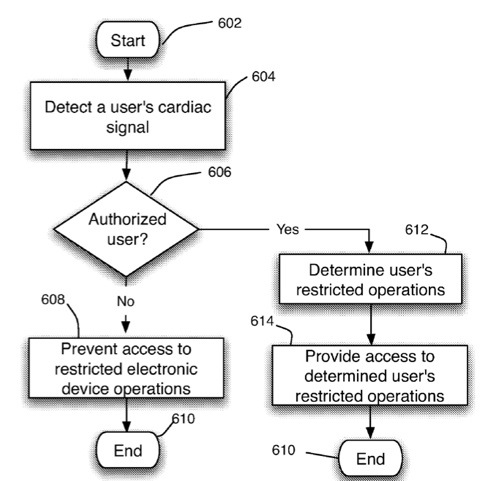Forget passwords and fingerprint technology. Apple is eyeing ways in which its devices can identity users by their heart beat. An Apple patent (number 20100113950) for a seamlessly embedded heart rate monitor has appeared at the US Patent & Trademark Office.
The patent is directed to an electronic device having an integrated sensor for detecting a user’s cardiac activity and cardiac electrical signals. The electronic device can include a heart sensor having several leads for detecting a user’s cardiac signals. The leads can be coupled to interior surfaces of the electronic device housing to hide the sensor from view, such that electrical signals generated by the user can be transmitted from the user’s skin through the electronic device housing to the leads. In some embodiments, the leads can be coupled to pads placed on the exterior of the housing.
The pads and housing can be finished to ensure that the pads are not visibly or haptically distinguishable on the device, thus improving the aesthetic qualities of the device. Using the detected signals, the electronic device can identify or authenticate the user and perform an operation based on the identity of the user. In some embodiments, the electronic device can determine the user’s mood from the cardiac signals and provide data related to the user’s mood. The inventors are Gloria Lin, Taido Nakajima, Pareet Rahul and Andrew Hodge.
Here’s Apple’s background and summary of the invention: “Many electronic devices are used to store personal or confidential information. In particular, portable electronic devices such as cellular telephones, personal assistants, and music players are often used to store or access e-mail, contact lists, communications history, remotely accessed accounts (e.g., telephone, banking or credit card accounts), or other information that a user may regard as personal or private. In addition, several users may use the same electronic device.
“For example, several users in a household may use the same computer or portable music player. As another example, a user may lend an electronic device to a friend (e.g., lend an iPod, available from Apple Inc. to a friend for a workout or a trip). To enhance each user’s experience with the electronic device, the electronic device can include several profiles that can be loaded and provided to the users of the device. Each profile can be associated with a particular user, and include several settings that allow the electronic device interface user interaction components, and available data or applications to be personalized for the user.
“The electronic device can use several approaches to identify the user of the electronic device and provide access to the user’s private and personal information, or to load the user’s personal profile. In some embodiments, the electronic device can identify or authenticate a user based on an input provided by the user, such as a password or key provided using an input mechanism. In some embodiments, the electronic device can include one or more sensors operative to detect a fingerprint, voice print, facial features, or other biometric characteristics of a user.
“Other biometric-based approaches can be used to authenticate a user. In some embodiments, an electronic device can authenticate a user based on the attributes of the user’s heartbeat. For example, the durations of particular portions of a user’s heart rhythm, or the relative size of peaks of a user’s electrocardiogram (EKG) can be processed and compared to a stored profile to authenticate a user of the device. To detect a user’s heartbeat or heart rhythm, however, the electronic device must provide at least two leads that the user contacts to detect the user’s cardiac signals.
“Although the leads can simply be placed on the exterior surface of the device housing, for example in a defined location where the user may place a finger, this approach is not aesthetically pleasing, and may cause some prospective buyers to consider other devices. In addition, such an approach may require the user to perform a specific authentication action–viz., placing a finger on the one or more leads, then unlocking or accessing the electronic device features (e.g., by moving a slider across the screen). This additional step may in fact be so encumbering that users disable the authentication feature and instead use an unsecured electronic device.
“This is directed to an electronic device having a seamlessly integrated cardiac sensor. The cardiac sensor can be integrated in any suitable portion of the electronic device, including for example a portion with which the user is typically in contact (e.g., an input mechanism or a housing held by the user), or metallic or conductive portions of the device.
“The electronic device can include any suitable type of electronic device, including for example a portable electronic device that the user may hold in hand (e.g., a portable media player or a cellular telephone), a larger portable electronic device (e.g., a laptop computer), or a substantially fixed electronic device. The electronic device may include software or hardware operative to process the output of a cardiac sensor to extract, from the received output, characteristics of the user’s heartbeat, heart rate, or other cardiac signals. For example, the electronic device may extract one or more characteristic durations associated with the user’s heart rate. As another example, the electronic device may extract one or more characteristic amplitudes or amplitude ratios associated with the user’s heart rate.
“Once the electronic device has identified one or more characteristics of the user’s heart rate, heartbeat, or other cardiac signals, the electronic device can compare the one or more identified characteristics with cardiac signal characteristics of authorized users that have been stored in memory. In response to determining that the identified characteristics correspond to those of an authorized user (e.g., match those stored in memory), the electronic device can provide the user with access to the electronic device and load the identified user’s personal settings and data.
“To determine the user’s heart rate, heartbeat, or other cardiac signals, the electronic device can include one or more sensors embedded in the device. The one or more sensors can include leads for receiving electrical signals from the user’s heart. For example, the one or more sensors can include leads associated with the user’s left and right sides, and lead associated with the ground. To provide an electrical signal from the user to the processing circuitry, the leads can be exposed such that the user may directly contact the leads, or may instead or in addition be coupled to an electrically conductive portion of the device enclosure (e.g., a metallic bezel or housing forming the exterior of the device).
“Because each electronic device can include several leads, the leads may be electrically isolated to avoid shorting or interference among leads. In some embodiments, an electrically isolating component can be inserted between adjacent leads. Alternatively, if the electronic device enclosure is constructed from a material having insufficient conductivity for transmitting detected cardiac electrical signals, the distance along the enclosure between adjacent leads can be sufficient to isolate the leads. In addition, to ensure that the aesthetic appeal and appearance of the electronic device is retained, one or more of the isolating components, the leads themselves, and the device enclosure can be finished using a suitable process to disguise the leads.
“In some embodiments, if the electrical conductivity of portions of the electronic device enclosure and the leads are suitably selected and designed, the leads can be positioned underneath the exterior surface of the enclosure while providing sufficient conductivity for detecting cardiac electrical signals and avoiding shorting or interference between adjacent leads. For example, the sensor leads can be constructed from a silver based compound having high electrical conductivity, while the electronic device enclosure can be constructed from steel and aluminum, both having lower electrical conductivity. By placing several leads at substantially larger distances apart along the electronic device enclosure than the thickness of the enclosure, electronic signals can be transmitted through the steel or aluminum enclosure to a silver based lead underneath the enclosure, but not along the surface of the enclosure to cause adjacent leads to short.”




